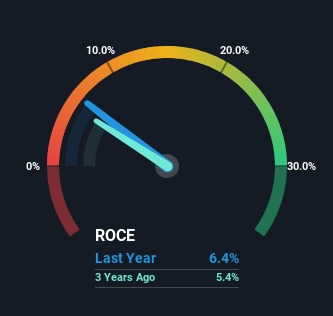Returns On Capital Are Showing Encouraging Signs At T. Hasegawa (TSE:4958)
What trends should we look for it we want to identify stocks that can multiply in value over the long term? Typically, we'll want to notice a trend of growing return on capital employed (ROCE) and alongside that, an expanding base of capital employed. If you see this, it typically means it's a company with a great business model and plenty of profitable reinvestment opportunities. So when we looked at T. Hasegawa (TSE:4958) and its trend of ROCE, we really liked what we saw.
Return On Capital Employed (ROCE): What Is It?
Just to clarify if you're unsure, ROCE is a metric for evaluating how much pre-tax income (in percentage terms) a company earns on the capital invested in its business. The formula for this calculation on T. Hasegawa is:
Return on Capital Employed = Earnings Before Interest and Tax (EBIT) ÷ (Total Assets - Current Liabilities)
0.064 = JP¥8.2b ÷ (JP¥141b - JP¥12b) (Based on the trailing twelve months to March 2024).
Thus, T. Hasegawa has an ROCE of 6.4%. In absolute terms, that's a low return but it's around the Chemicals industry average of 6.7%.
View our latest analysis for T. Hasegawa

While the past is not representative of the future, it can be helpful to know how a company has performed historically, which is why we have this chart above. If you're interested in investigating T. Hasegawa's past further, check out this free graph covering T. Hasegawa's past earnings, revenue and cash flow.
The Trend Of ROCE
We're glad to see that ROCE is heading in the right direction, even if it is still low at the moment. The data shows that returns on capital have increased substantially over the last five years to 6.4%. The amount of capital employed has increased too, by 22%. So we're very much inspired by what we're seeing at T. Hasegawa thanks to its ability to profitably reinvest capital.
The Bottom Line On T. Hasegawa's ROCE
In summary, it's great to see that T. Hasegawa can compound returns by consistently reinvesting capital at increasing rates of return, because these are some of the key ingredients of those highly sought after multi-baggers. Since the stock has returned a solid 67% to shareholders over the last five years, it's fair to say investors are beginning to recognize these changes. Therefore, we think it would be worth your time to check if these trends are going to continue.
On the other side of ROCE, we have to consider valuation. That's why we have a FREE intrinsic value estimation for 4958 on our platform that is definitely worth checking out.
While T. Hasegawa isn't earning the highest return, check out this free list of companies that are earning high returns on equity with solid balance sheets.
Valuation is complex, but we're here to simplify it.
Discover if T. Hasegawa might be undervalued or overvalued with our detailed analysis, featuring fair value estimates, potential risks, dividends, insider trades, and its financial condition.
Access Free AnalysisHave feedback on this article? Concerned about the content? Get in touch with us directly. Alternatively, email editorial-team (at) simplywallst.com.
This article by Simply Wall St is general in nature. We provide commentary based on historical data and analyst forecasts only using an unbiased methodology and our articles are not intended to be financial advice. It does not constitute a recommendation to buy or sell any stock, and does not take account of your objectives, or your financial situation. We aim to bring you long-term focused analysis driven by fundamental data. Note that our analysis may not factor in the latest price-sensitive company announcements or qualitative material. Simply Wall St has no position in any stocks mentioned.
Have feedback on this article? Concerned about the content? Get in touch with us directly. Alternatively, email editorial-team@simplywallst.com
About TSE:4958
T. Hasegawa
Produces, sells, imports, and exports fragrances, flavors, aromatic chemicals, food additives, and foods in Japan and internationally.
Flawless balance sheet established dividend payer.
Similar Companies
Market Insights
Community Narratives




